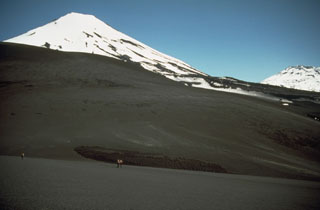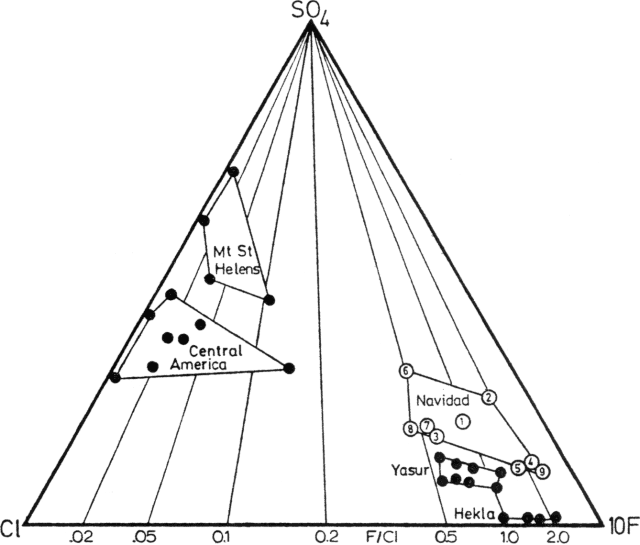Report on Lonquimay (Chile) — July 1989
Scientific Event Alert Network Bulletin, vol. 14, no. 7 (July 1989)
Managing Editor: Lindsay McClelland.
Lonquimay (Chile) Strombolian activity and lava effusion; gas chemistry
Please cite this report as:
Global Volcanism Program, 1989. Report on Lonquimay (Chile) (McClelland, L., ed.). Scientific Event Alert Network Bulletin, 14:7. Smithsonian Institution. https://doi.org/10.5479/si.GVP.SEAN198907-357100
Lonquimay
Chile
38.379°S, 71.586°W; summit elev. 2832 m
All times are local (unless otherwise noted)
Weak Strombolian activity continued in July, and the rate of ashfall increased in the Lonquimay valley. As the eruption persisted and concerns remained about health effects of the volcanic gases, particularly fluorine, residents continued to leave the area. Around 8 July, a small gravitational collapse occurred at the tephra cone in the NE part of Navidad Crater. Peter Baker has analyzed 4 February lava and 28 December ash for fluorine, yielding values of 1,638 and 3,401 ppm, respectively. Oscar González-Ferrán notes that no other high-fluorine eruption has been reported from a volcano in the Andes.
A team of geologists (Marino Martini, Luciano Gianinni, Philip Kyle, Werner Giggenbach, Jon Bjornvinsson, Oscar González-Ferrán, Hugo Moreno, José Naranjo, and Rodolfo Figueroa) carried out fieldwork at Lonquimay 7-17 July, using several techniques to measure gases. Transportation was provided by the Chilean Air Force. The following is from J. Naranjo and W. Giggenbach.
Eruptive activity, 9 July 1989. Navidad Cone continued to produce small ash emissions and lava. Since early April, its eruptive activity has clearly decreased to a VEI of 1 or less. On 9 July, ash clouds were rising to 500-700 m above the crater, and after unusually strong explosions to 1,000 m. A heavy snowfall on 30 June was covered by an ash deposit that indicated a main plume direction to the SSE, between the towns of Malalcahuello and Lonquimay. Average ash accumulation rates at El Mirador, 1.5 km SSE of Navidad, were about 2.2 mm/day in early July, considerably lower than the 6 mm/day estimated for the first 3 months of the eruption. The rate of lava effusion, estimated 400 m from the source, was about 50,000 m3/hour, similar to the 60,000 m3/hour reported for the eruption's first 100 days (Moreno and Gardeweg, 1989). The lava was traveling NE down the Lolco valley, while advance of the N lobe (toward Laguna Verde) appeared to have stopped.
"Navidad's black scoria cone has grown to 300 m high, with a basal diameter of ~800 m. On 9 July at about 1100, the crater, breached to the N, contained a small lava lake halfway up the southern crater wall. Strombolian eruptions, emanating from there every few minutes, splashed lava over the inner crater walls. Bombs occasionally reached the outer slopes. A light gray steam and ash column was emitted from a vent next to the lava lake. At about 1200, another vent opened abruptly some 80 m below the active lava pool, extruding an initially dome-shaped batch of new lava accompanied by spectacular lava fountaining for about 5 minutes. The new batch of lava quickly spread downhill to join the existing lava tongue. This process appeared to have drained the lava conduit, as Strombolian eruptions from the now-empty lava lake had ceased, producing instead an almost constant stream of ash-charged gas. Strombolian explosions resumed at around 1330, the conduit having obviously refilled. Direct observation ended at 1430.
Gas chemistry. "Following reports of extensive livestock losses (cattle, sheep, and poultry) and of detrimental health effects or even deaths of inhabitants of areas affected by the volcanic plume, an effort was made to measure the possibly harmful components of gases emitted by the volcano. However, the activity made it impossible to directly approach the degassing vents and recent snowfall prevented access to the advancing, actively degassing lava fronts. The only available samples were ashes deposited since the last snowfall on 30 June. Nine samples were collected on 9 July, from the immediate vicinity of the cone (1, 2), the Mirador area (3-6), the Refugio (7, 8), and about 10 km from the vent (9). The samples are fresh, well-sorted, vesiculated scoriaceous fragments, with grain sizes decreasing from 0.3-3 mm for sample 1 to 0.1-0.3 mm for sample 9. Samples were leached with distilled water and analyzed for Li, K, Mg, Ca, Al, Si, NO3, SO4, F, Cl, Br, and trace constituents. Figure 13 compares relative SO4, Cl, and F contents in the leachates with those from other volcanic ashes.
"Although absolute amounts of salts leached from the ash samples may vary by several orders of magnitude, relative contents are remarkably similar and fall into distinct groups. The quite narrow scatter for a given area suggests that the leachate compositions reflect actual variations in compositions of gases released from a volcanic system rather than secondary processes. The Navidad samples fall within the group represented by Hekla and Yasur, having F/Cl atomic ratios up to 100 times those of the low fluoride group (Mt. St. Helens, Central America). The detrimental effect of high F contents in volcanic ash on grazing animals is well documented for Hekla (Thorarinsson and Sigvaldason, 1972). There, leachable F reached 2,000 mg/kg ash, compared to up to 100 mg/kg at Lonquimay.
"The samples were deposited during a period of dry weather and after the eruption had subsided considerably. During the early, more active period, and under more humid conditions, leachable F contents of the Navidad ash may have been considerably higher. At the state of activity and atmospheric conditions encountered at the beginning of July, however, it is unlikely that the Navidad gases cause any harm to people or animals. It appears highly advisable, though, to monitor F contents in drinking water and animal feed, especially during the thaw of F-charged snow in spring."
SO2 data. Philip Kyle made a series of COSPEC V measurements on 13 July between 1339 and 1513. SO2 flux ranged from 83 to 302 t/d, with an average of 169 ± 48 t/d (161 data points). An increase in the emission rate was evident beginning at 1353, continuing through the final measurements at 1513. A stronger increase between 1412 and 1427 was superimposed on the general trend. Video tapes of the activity during this period show no visible changes that could be correlated with the increased SO2 emission.
The following is a report from Marino Martini. "The chemical composition of water collected in the Lonquimay area does not signal important contamination from the effects of ash or acid rain (table 7). The fluorine content, in particular, does not seem to constitute a reason for alarm, and water on the slope that supplies the city does not have negative chemical characteristics. Concentrations of acid species can also be observed in snow samples (table 7), but without important effects on potable water.
Table 7. Partial chemical compositions (in ppm) of water and snow near Lonquimay. Courtesy of M. Martini.
| Location | Source | HCO3 | Cl | SO4 | NO3 | F | NH4 |
| Malalcahuello | Water | 46.3 | 0.89 | 3.4 | 1.9 | 0.05 | 0.31 |
| Lonquimay (reserve) | Water | 23.2 | 11.4 | 6.1 | 1.2 | 0.31 | 0.27 |
| Rio Naranjo | Water | 23.2 | 19.2 | 3.0 | 3.5 | 0.31 | 0.45 |
| Lonquimay (vert.) | Water | 62.2 | 1.60 | 17.9 | 1.4 | 0.04 | 0.68 |
| Rocapacheco (well) | Water | 45.7 | 11.4 | 11.1 | 23.4 | 0.04 | 1.00 |
| Laguna S. Pedro | Water | -- | 3.5 | 0.4 | -- | 0.45 | 0.18 |
| Hill 9 (toward Lonquimay) | Snow | -- | 2.4 | 0.20 | 0.03 | 0.22 | -- |
| Hill 9 (toward the volcano) | Snow | -- | 3.4 | 0.93 | 0.15 | 0.38 | -- |
| Hill 9 (toward the volcano) | Snow | -- | 4.2 | 2.23 | 0.36 | 0.47 | -- |
| 2 km from volcano (helicopter) | Snow | -- | 8.1 | 1.20 | 0.03 | 1.27 | -- |
"The Strombolian activity did not permit a direct approach to crater fumaroles, so only indirect observations were possible. Nevertheless, given previous experience, the information that could be obtained has substantial validity. The natural gas condensates, collected near the lava flow that emerges from the active crater, are impoverished in the most volatile constituents (CO2, SO2), but it is possible to gather sufficient general information. A comparison with natural condensates from Vulcano (Italy) indicates that in spite of the different type of volcano and the absence of a lava flow, we can ascertain relations of the same order between Cl, F, and S (the higher concentrations of B and Br at Vulcano are related to the influence of the marine atmosphere). If we consider the F/SO2 ratio of the gases emitted by fumaroles at Vulcano with reference to the value measured for the natural condensate, we can then estimate an approximate F/SO2 of 0.012 for the Lonquimay gases (table 8)."
Table 8. Natural condensates of fumarolic gases (in ppm) at Lonquimay and Vulcano. Courtesy of M. Martini.
| Volcano | Cl | F | S | B | Br | F/S | F/SO2 (estimated) |
| Lonquimay | 258,000 | 1030 | 110 | 88 | 43 | 9.3 | 0.012 |
| Vulcano | 100,560 | 620 | 50 | 345 | 260 | 12.4 | 0.0151 |
References. Moreno, H., and Gardeweg, M., 1989, La erupción reciente en el Complejo Volcánico Lonquimay (Diciembre 1988-), Andes del Sur: Revista Geológica de Chile, v. 16, p. 93-117.
Nehring, N.L., and Johnston, D.A., 1981, Use of ash leachates to monitor gas emissions, in Lipman, P.W. and Mullineaux, D.R. (eds.), The 1980 eruptions of Mt. St. Helens, Washington: USGS Professional Paper 1250, p. 251-256.
Oskarsson, N., 1980, The interaction between volcanic gases and tephra: fluorine adhering to tephra of the 1970 Hekla eruption: JVGR, v. 8, p. 251-266.
Taylor, P.S., and Stoiber, R.E., 1973, Soluble material on ash from active Central American volcanoes: GSA Bulletin, v. 84, p. 1031-1042.
Thorarinsson, S., and Sigvaldason, G.E., 1972, The Hekla eruption of 1970: BV, v. 36, p. 269-288.
Geological Summary. Lonquimay is a small, flat-topped, symmetrical stratovolcano of late-Pleistocene to dominantly Holocene age immediately SE of Tolguaca volcano. A glacier fills its summit crater and flows down the S flank. It is dominantly andesitic, but basalt and dacite are also found. The prominent NE-SW Cordón Fissural Oriental fissure zone cuts across the entire volcano. A series of NE-flank vents and scoria cones were built along an E-W fissure, some of which have been the source of voluminous lava flows, including those during 1887-90 and 1988-90, that extended out to 10 km.
Information Contacts: O. González-Ferrán, Univ de Chile; J. Naranjo, SERNAGEOMIN, Santiago; W. Giggenbach, Chemistry Division, DSIR, New Zealand; M. Martini, Univ of Firenze, Italy; P. Kyle, New Mexico Institute of Mining and Technology, Socorro; P. Baker, Univ of Nottingham, UK.


